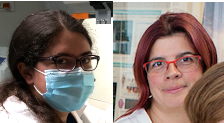 Laure de Pontual was awarded the Masters 2020* prize by the French Myology Society (SFM). This prize was a reward for her excellent academic record, her work in the 2nd year of her Masters in the field of myology, and as an encouragement for her proposed thesis that she presented on 20 January 2020, during the “Young Hopefuls in Myology” seminar. Her thesis, relating to the identification of new factors involved in the formation of CTG repeat contractions in myotonic dystrophy type 1 (DM1), will be pursued at the Myology Research Centre in the Furling/Gourdon team, at the Institute of Myology. An interview with Laure de Pontual and Stéphanie
Laure de Pontual was awarded the Masters 2020* prize by the French Myology Society (SFM). This prize was a reward for her excellent academic record, her work in the 2nd year of her Masters in the field of myology, and as an encouragement for her proposed thesis that she presented on 20 January 2020, during the “Young Hopefuls in Myology” seminar. Her thesis, relating to the identification of new factors involved in the formation of CTG repeat contractions in myotonic dystrophy type 1 (DM1), will be pursued at the Myology Research Centre in the Furling/Gourdon team, at the Institute of Myology. An interview with Laure de Pontual and Stéphanie  Tomé, her thesis supervisor.
Tomé, her thesis supervisor.
How does your proposal fit in with the laboratory’s areas of interest?
The Furling/Gourdon team’s main research area of interest is myotonic dystrophy type 1, a neuromuscular disease caused by unstable CTG triplet expansion, occurring during the patient’s life, but also between successive generations. Furthermore, the severity of DM1 is directly related to the size of the CTG expansions.
In the Gourdon group, researchers are pursuing three areas of interest: the first, concerning the DNA, relates to the mechanisms involved in the instability of the CTG repeats; the second relates to the molecular and pathophysiological consequences of these triplet repeats; and the third relates to therapeutic tests in a mouse model of DM1, created by G. Gourdon in the 1990s.
My proposed thesis relates precisely to the instability of the CTG triplets, and a researcher specialising in this area, Stéphanie Tomé, is supervising me. It involves understanding the mechanisms underlying this instability, in order to develop different therapeutic approaches aimed at reducing the size of the repeats directly, at the DNA level, to reduce the severity of the symptoms, or at removing these numerous abnormal repeats altogether.
How will you decipher these mechanisms?
The proposal involves two parts, conducted in parallel. The first part consists of identifying new genes involved in the formation of CTG contractions (decrease in the size of the repeats), using different cell models available in the laboratory. Genetic screening using the CRISPR/Cas9 technology is underway, and will help to identify candidates that will be validated in patient cells. This mechanistic, more fundamental part is very important in developing new therapeutic strategies aimed at decreasing triplet size, and therefore severity and age of onset of the symptoms in patients.
Does your project involve a part that is more directed at therapeutics?
Indeed, the second part is more applied, and is aimed at identifying chemical molecules that might have a direct action on CTG expansions by decreasing their size in a DM1 context. Chemical screening has helped to identify candidate molecules that are currently undergoing validation in various cell models. Depending on the results, the laboratory’s mouse model could be used in the context of preclinical studies, so that a therapy may be possible in the long term.
* This prize rewards a young researcher for the quality of their 2nd year of Masters work in biology in the field myology (clinical or fundamental research).
